NVIDIA GeForce GTX 690 Review: Ultra Expensive, Ultra Rare, Ultra Fast
by Ryan Smith on May 3, 2012 9:00 AM ESTOverclocked: Power, Temperature, & Noise
Our final task is our look at GTX 690’s overclocking capabilities. NVIDIA has told us that with GTX 690 they weren’t just looking to duplicate GTX 680 SLI’s performance, but also its overclocking capabilities. This is quite the lofty goal, since with GTX 690 NVIDIA is effectively packing 2 680s into the same amount of space, leaving far less space for VRM circuitry and trace routing.
| GeForce 600 Series Overclocking | ||||
| GTX 690 | GTX 680 | |||
| Shipping Core Clock | 915MHz | 1006MHz | ||
| Shipping Max Boost Clock | 1058MHz | 1110MHz | ||
| Shipping Memory Clock | 6GHz | 6GHz | ||
| Shipping Max Boost Voltage | 1.175v | 1.175v | ||
| Overclock Core Clock | 1040MHz | 1106MHz | ||
| Overclock Max Boost Clock | 1183MHz | 1210MHz | ||
| Overclock Memory Clock | 7GHz | 6.5GHz | ||
| Overclock Max Boost Voltage | 1.175v | 1.175v | ||
In practice NVIDIA has not quite kept up with GTX 680, and in other ways completely exceeded it. When it comes to the core clock we didn’t quite reach parity with our reference GTX 680; the GTX 680’s highest boost clock bin could hit 1210MHz, while the GTX 690’s highest boost clock bin topped out at 1183MHz, some 27MHz (2%) slower.
On the other hand, our memory overclock is so high as to be within the “this doesn’t seem physically possible” range. As we have discussed time and time again, GDDR5 memory busses are difficult to run at high clocks on a good day, never mind a bad day. With GF110 NVIDIA couldn’t get too far past 4GHz, and even with GTX 680 NVIDIA was only shipping at 6GHz.
It would appear that no one has told NVIDIA’s engineers that 7GHz is supposed to be impossible, and as a result they’ve gone and done the unthinkable. Some of this is certainly down to the luck of the draw, but it doesn’t change the fact that our GTX 690 passed every last stability test we could throw at it at 7GHz. And what makes this particularly interesting is the difference between the GTX 680 and the GTX 690 – both are equipped with 6GHz GDDR5 RAM, but while the GTX 680 is equipped with Hynix the GTX 690 is equipped with Samsung. Perhaps the key to all of this is the Samsung RAM?
In any case, our final result was a +125MHz core clock offset and a +1000MHz memory clock offset, which translates into a base clock of 1040MHz, a max boost clock of 1183MHz, and a memory clock of 7GHz. This represents a 12%-14% core overclock and a 17% memory overclock, which is going to be enough to put quite the pep in the GTX 690’s step.
As always we’re going to start our look at overclocking in reverse, beginning with power, temperature, and noise. For the purpose of our testing we’ve tested our GTX 690 at two different settings: at stock clocks with the power target set to 135% (GTX 690 PT), and with our custom overclock alongside the same 135% power target (GTX 690 OC). This allows us to look at both full overclocking and the safer option of merely maxing out the boost clocks for all they’re worth.
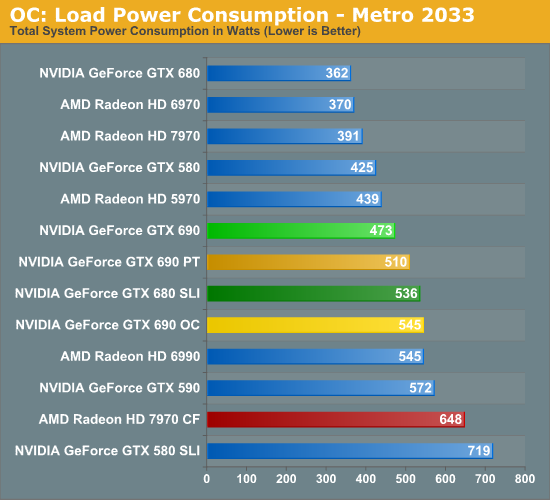

As expected, merely increasing the power target to 135% was enough to increase the GTX 690’s power consumption, though overclocking further adds to that. Even with the power target increase however, the power consumption at the wall for the GTX 690 is still lower than the GTX 680 SLI by over 20W, which is quite impressive. As we’ll see in our section on performance this is more than enough to erase the GTX 690’s performance gap, meaning at this point its still consuming less power than the GTX 680 SLI while offering better performance than its dual-card cousin.
It’s only after outright overclocking that we finally see power consumption equalize with the GTX 680 SLI. The overclocked GTX 690 is within 10W of the GTX 680 SLI, though as we’ll see the performance is notably higher.
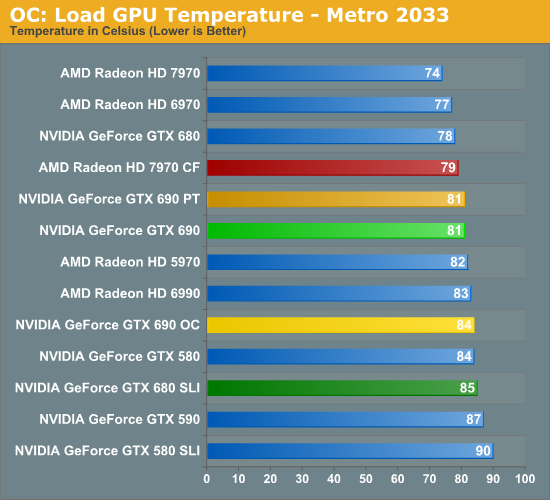
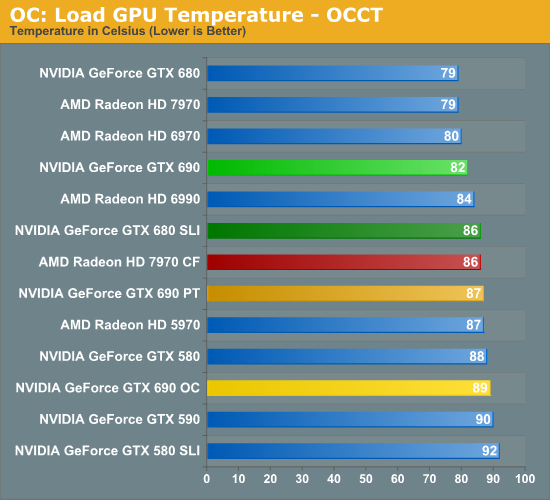
What does playing with clocks and the power target do to temperatures? The impact isn’t particularly bad, though we’re definitely reaching the highest temperatures we really want to hit. For the GTX 690 PT things are actually quite good under Metro, with the temperature not budging an inch even with the higher power consumption. Under OCCT however temperatures have risen 5C to 87C. Meanwhile the GTX 690 OC reaches 84C under Metro and a toasty 89C under Metro. These should be safe temperatures, but I would not want to cross 90C for any extended period of time.
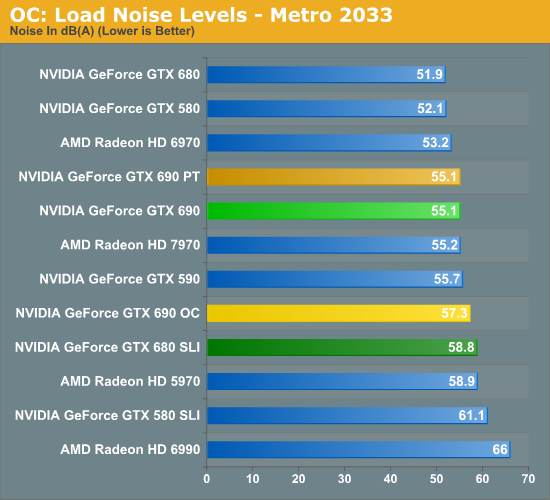
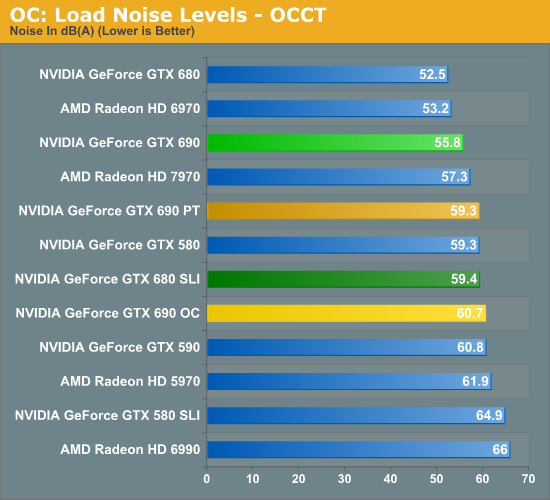
Finally we have load noise. Unsurprisingly, because load temperatures did not go up for the GTX 690 PT under Metro load noise has not gone up either. On the other hand load noise under OCCT has gone up 3.5dB, making the GTX 690 PT just as loud as our GTX 680 SLI in its adjacent configuration. In practice the noise impact from raising the power target is going trend closer to Metro than OCCT, but Metro is likely an overly optimistic scenario; there’s going to be at least a small increase in noise here.
The GTX 690 OC meanwhile approaches the noise level of the GTX 680 SLI under Metro, and shoots past it under OCCT. Considering the performance payoff some users will no doubt find this worth the noise, but it should be clear that overclocking like this means sacrificing the stock GTX 690’s quietness.










200 Comments
View All Comments
InsaneScientist - Sunday, May 6, 2012 - link
Except that nVidia wins in the article and all of the accumulated benches here, even at 1920x1200 (which this card would be a complete waste on...), so what exactly are you complaining about?It's bias if they say that the AMD cards are better when they're not, but in the benchmarks and in the conclusions (here and elsewhere), nVidia is consistently ahead, so any claims of bias are completely groundless...
CeriseCogburn - Tuesday, May 8, 2012 - link
Read my first post instead of asking or having already read it attack like you just did and continue to be a jerk who cares, right ?You obviously are all seriously upset about the little facts I gave in my very first post. You're all going bonkers over it, and you all know I'm correct, that's what really bothers all of you.
Continue to be bothered, you cannot help it, that's for sure.
Sabresiberian - Thursday, May 3, 2012 - link
It's certainly not crazy, I'd certainly run 3 1920x1200 monitors over 3 1920x1080s.;)
CeriseCogburn - Thursday, May 3, 2012 - link
I guess all of you got very upset that my point was made, you're looking at a biased for amd set of benchmarks. I'm sure most of you are very happy about that, but angered it has been effectively pointed out.Makaveli - Thursday, May 3, 2012 - link
The only thing were are upset about is your being a tool!And what point? you haven't shown a shread of evidence to back up this bias claim only whats floating around in your head!
CeriseCogburn - Sunday, May 6, 2012 - link
Go look at the link you missed since you cannot read and only attack and call names.james.jwb - Thursday, May 3, 2012 - link
I always love these guys who behave like this.On the one hand, if they are trolling just for the reaction, it's fascinating. What kind of weird creature lies behind the internet persona? In most cases, we all know it must be a sad figure of a person with all sorts of interesting personality problems.
But on the flip side, if this person actually means and believes what they say is some sort of honest analysis, it's just as fascinating. What kind of thick bastard must then lurk behind the keyboard in question?
It boggles the mind :)
silverblue - Thursday, May 3, 2012 - link
Reminds me of SiliconDoc. That particular numpty got banned as far as I remember.Galidou - Thursday, May 3, 2012 - link
I think that these creatures are Nvidia's fanboy, they react always the same way. CeriseCogburn remember me one of them a little while ago, can't remember his name. He was convinced that the 7970 pricing was the worst thing to ever happen to humanity since the birth of Justin Bieber, or at least, it looked alot like that. Sure the price wasn't attractive, but there's some limit you must not cross to stay in the real world.So as weird a creature they can be, I believe they are a result of Nvidia's funding them to spread insanity in forums speaking of video cards. They can't be natural things after all, they just don't make sense. Their closed mind is second to none. Or else, they could only have the possibility to type insanities and a filter to read the replies to stop some information entering their brain.
Parhel - Friday, May 4, 2012 - link
Do you really think ATI and nVidia would pay these weird, sad, little trolls to piss off readers every time one of their products is reviewed? It's an embarassment and a distraction. No, I think they would pay someone like that NOT to talk about their products if they could. I'm sure that employees do write comments on product reviews, but guys like this are bad for business. Nobody wants someone like that on their side. If I were nVidia, I'd pay that guy to become an AMD fan!!!